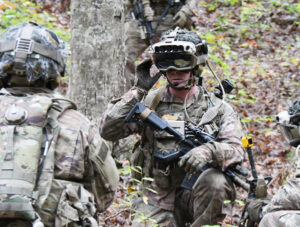The Pentagon’s inspector general has found the Army “did not define minimum user acceptance levels” for its Integrated Visual Augmentation System (IVAS) program, a move the office said risks potentially ‘wasting’ $22 billion if soldiers don’t want to use the new headset.
The partially-redacted public version of the DoD IG’s audit
of the IVAS program, released on Friday, details several recommendations for evaluating user acceptance levels while the office noted the Army’s acquisition office did not fully agree with the steps proposed in the report.

“Army testing officials assessed user acceptance from soldiers who used IVAS during various operational tests and used the results of those surveys to make changes to the system. However, IVAS program officials did not define minimum user acceptance levels to determine whether IVAS would meet user needs. This occurred because Army policy did not require program officials to define suitable user acceptance levels,” the DoD IG writes in its report. “Procuring IVAS without attaining user acceptance could result in wasting up to $21.88 billion in taxpayer funds to field a system that Soldiers may not want to use or use as intended.”
The DoD IG’s office announced plans in October to conduct an audit of the IVAS program, which followed the Army’s confirmation it had delayed the first unit equipped date out to later in 2022 and acknowledged an issue with the system’s waveguide technology that was causing resolution issues (Defense Daily, Oct. 18 2021).
In its report, the Pentagon’s watchdog office calls on the Army’s acquisition office to develop a service-wide policy “requiring program officials to define suitable user acceptance measurements for testing and evaluation.”
More specifically, it asks Program Executive Office-Soldier, which oversees IVAS, to define “clear measures of user acceptance levels” before beginning the fifth soldier touchpoint to test the headset and urges the Army’s acquisition office to verify whether the program office has established such measures and addressed soldier-identified issues before moving into production.
The Army’s assistant secretary for acquisition, logistics and technology (ASA (ALT)), however, disagreed with the DoD IG’s recommendation to issue policy around user acceptance measurements, arguing similar criteria exists in regulations around evaluating a system’s effectiveness and suitability, according to the report.
“However, for the IVAS program, user acceptance is a measure of effectiveness, but thresholds and objectives are not clearly specified due to lack of Army policy. Therefore, the recommendation is unresolved. We request that the assistant secretary reconsider his position on the recommendation and provide comments on the final report,” the DoD IG’s office wrote.
The DoD IG’s office noted ASA (ALT) partially agreed with the recommendation for PEO Soldier, but said it should be focused on “explaining” user acceptance measures rather than defining specific criteria, with the report noting this proposal was unchanged and the issues remains “unresolved.”
“Although the ASA (ALT) agreed with the recommendation to verify whether PEO Soldier meets established user acceptance measures, he did not agree with recommendation two,” the DoD IG’s office wrote. “Because Army officials must define clear measures of user acceptance levels to implement this recommendation, the recommendation is unresolved pending the revised response to Recommendation 2.”
Last March, the Army awarded Microsoft [MSFT] a deal worth up to $21.9 billion over the next 10 years to move the IVAS program from rapid prototyping into production (Defense Daily, March 31 2021).
Doug Bush, the Army ASA (ALT), told reporters in February it’s unlikely the service will spend the maximum $22 billion allowed under its current production contract for IVAS (Defense Daily, Feb. 18).
Lawmakers have already placed $350 million of the total $405.1 million for IVAS procurement in FY ‘22 on hold until the completion of IVAS’ initial operational test and evaluation and after Army officials brief Congress on the status of the program (Defense Daily, March 14).